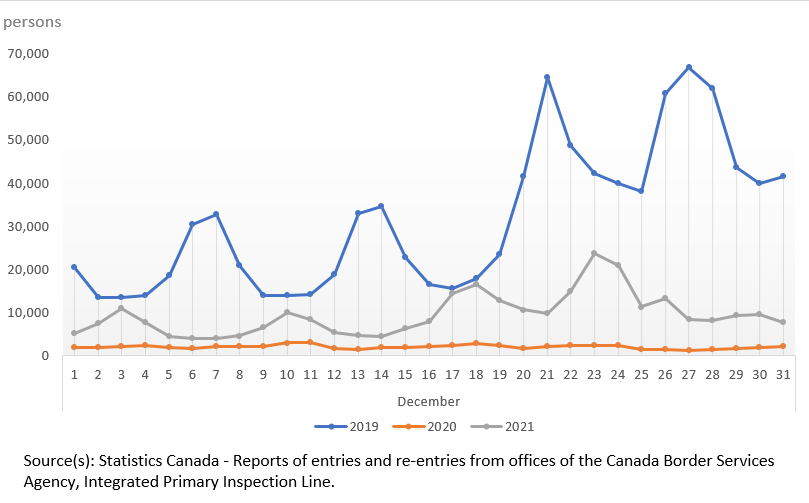Leading indicator of international arrivals to Canada, December 2021
Archived Content
Information identified as archived is provided for reference, research or recordkeeping purposes. It is not subject to the Government of Canada Web Standards and has not been altered or updated since it was archived. Please "contact us" to request a format other than those available.
Released: 2022-01-12
Highlights
December saw the number of international arrivals to Canada increase sharply from the same month in 2020, but remain well below the pre-pandemic levels of December 2019.
Compared with December 2020, more than 10 times as many non-resident travellers arrived from abroad at Canadian airports equipped with electronic kiosks during December 2021. This was less than two-thirds of the number for December 2019, prior to the pandemic.
At the same time, the number of Canadian residents returning from abroad via the same airports was almost eight times greater than December 2020 and almost two-thirds of the number from the same month in 2019.
US residents made 291,600 trips to Canada through land ports with electronic sensors in December 2021, over 230,000 more than December 2020 and less than one-third of the 977,200 US arrivals by car during December 2019.
Similarly, compared with December 2020, there were over 460,000 more Canadians—for a total of 608,900—who returned from the United States through the same land ports. This was less than one-third of the 1.9 million Canadians who drove back across the border in the same month of 2019.
This release provides a first glimpse of international arrivals to Canada in December 2021. Complete counts will be available with the release of December data for "Travel between Canada and other countries" on February 23, 2022.
Restrictions tightening
By December 2021, Canada's borders were open to all fully vaccinated non-resident travellers, with international flights permitted to land at 18 Canadian airports. And since early November, the US land border was open to all fully vaccinated Canadian travellers.
In late November however, the World Health Organization declared a new variant of concern, Omicron, prompting Canada to implement new travel restrictions. As of December 15, the Government of Canada advised Canadians to avoid non-essential travel outside of Canada. On December 21, the requirement for a negative molecular test for all travellers entering Canada, regardless of trip length, went into effect.
Non-resident arrivals by air
Arrivals of non-residents—from overseas countries (196,500) and the United States (156,400)—at Canadian airports equipped with Primary Inspection Kiosks (PIKs) numbered 352,900 in December, up from 32,500 in December 2020. Despite this increase, it is less than two-thirds (61.1%) of the 577,800 such arrivals during the same month in 2019.
Some of the December 2021 increase comes from the inclusion of international arrivals at Toronto Pearson International Airport Terminal 1, where the PIK system was fully implemented as of June 22, 2021 (see Note to readers).
Non-resident arrivals by car
In December, US residents took 291,600 trips to Canada in US-licensed automobiles through 111 land ports equipped with the automated Integrated Primary Inspection Line (IPIL) application. While almost five times more than the 61,000 trips taken in December 2020, it remained less than one-third (29.8%) of the 977,200 US arrivals by car during the same month in 2019.
Canadians returning by air
The number of Canadian residents flying back from abroad in December via airports equipped with PIKs was 742,400, up sharply from 93,800 in December 2020. This was almost two-thirds (64.6%) of the number from the same month in 2019, prior to the pandemic.
Again however, some of the year-over-year increase reflects the inclusion of international arrivals at Toronto Pearson International Airport Terminal 1 (see Note to readers).
Canadians returning by car
In December, there were 608,900 Canadian residents who returned from the United States in Canadian-licensed automobiles via the 111 IPIL land ports. While more than four times the 146,000 recorded in December 2020, it is less than one-third (31.8%) of the 1.9 million Canadians who drove back across the border in the same month of 2019.
The impact of the molecular pre-entry test requirement that went into effect on December 21, 2021 is clear. In the first 20 days of the month, an average of 24,600 Canadian residents per day returned from the United States. After the testing requirement went into effect, this daily average decreased by more than half (10,600).
Note to readers
This indicator uses administrative data from the Canada Border Services Agency on international travellers entering the country by automobile and by air.
Counts of travellers entering the country by air are from the Primary Inspection Kiosk (PIK) system and represent a subset of arrivals by air. Pre-pandemic PIK systems captured approximately 58% of international arrivals, as it excluded Toronto Pearson International Airport Terminal 1, where PIKs were not yet deployed.
PIKs have been deployed at Toronto Pearson International Airport Terminal 1 since June 22, 2021, and these arrivals are now included in the total counts. The new, and higher, coverage rate will be calculated when a complete year of international traffic is observed for all Canadian airports receiving international flights.
Counts of cross-border travel by automobile through 111 land ports equipped with the automated Integrated Primary Inspection Line (IPIL) system are available by the traveller's state or province of residence, based on the licence plate of the automobile, and by the province of entry into Canada.
The IPIL data are a subset of Canadian and US residents entering Canada by automobile and exclude some crossings. In 2020, the 111 IPIL ports captured approximately 80% of cross-border automobile traffic between Canada and the United States.
Contact information
For more information, or to enquire about the concepts, methods or data quality of this release, contact us (toll-free 1-800-263-1136; 514-283-8300; infostats@statcan.gc.ca) or Media Relations (statcan.mediahotline-ligneinfomedias.statcan@statcan.gc.ca).
- Date modified:





